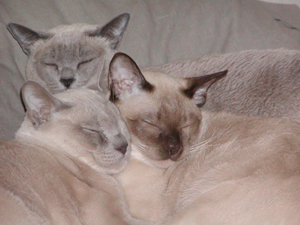Tonkinese cat
Tonkinese cat is a breed of domestic cat that is known for its strikingly beautiful appearance and friendly, sociable nature. The Tonkinese breed was developed by crossing the Siamese and the Burmese breeds, aiming to create a cat with a moderate body type and a unique personality. This breed is characterized by its muscular, yet svelte body, distinctive pointed coat pattern, and engaging aqua-colored eyes.
History[edit | edit source]
The origins of the Tonkinese cat can be traced back to the mid-20th century, although cats with similar characteristics have been mentioned in historical documents centuries earlier. The deliberate breeding program that led to the establishment of the Tonkinese as a recognized breed began in the 1960s and 1970s in Canada and the United States. Breeders sought to combine the best traits of the Siamese and Burmese, resulting in a breed that exhibited the sociable and affectionate nature of both parent breeds, along with a unique physical appearance.
Characteristics[edit | edit source]
Appearance[edit | edit source]
Tonkinese cats have a striking appearance, with a medium-sized, muscular body that is neither too slender like the Siamese nor too stocky like the Burmese. Their coat is short, silky, and comes in a variety of colors and patterns, including mink, solid, and pointed, with the mink coat pattern being the most distinctive and sought after. The colors can range from platinum to champagne, natural mink, and blue. Their eyes are a captivating shade of aqua, a trait inherited from their Siamese ancestry.
Temperament[edit | edit source]
Tonkinese cats are known for their outgoing, friendly, and playful nature. They are highly sociable and enjoy the company of humans and other pets alike. These cats are often described as "people-oriented," seeking out interaction and affection from their owners. They are intelligent and curious, which makes them easy to train and capable of learning tricks. Their vocalizations are softer and less frequent than those of the Siamese, but they will communicate their needs and desires to their owners.
Care[edit | edit source]
Caring for a Tonkinese cat involves regular grooming, feeding, and health maintenance. Their short coat requires minimal grooming, but regular brushing can help remove loose hair and maintain the coat's shine. As with all breeds, Tonkinese cats benefit from a balanced diet and regular veterinary check-ups to ensure they remain healthy and happy. They are generally healthy cats, but they can be prone to genetic health issues common to their Siamese and Burmese ancestors, such as dental problems and respiratory conditions.
Breeding and Recognition[edit | edit source]
The Tonkinese breed has gained recognition from major cat fancier associations, including the Cat Fanciers' Association (CFA) and the International Cat Association (TICA). Breeders adhere to specific standards to maintain the breed's physical and temperamental traits. The breeding of Tonkinese cats is regulated to ensure the health and well-being of the breed, with a focus on preserving its unique characteristics.
Conclusion[edit | edit source]
The Tonkinese cat is a delightful blend of its Siamese and Burmese heritage, offering the best of both worlds in terms of appearance, personality, and companionship. Their sociable nature and beautiful appearance make them a popular choice for families and individuals alike. As with any pet, prospective owners should ensure they are prepared to provide the care and attention these charming cats deserve.
Search WikiMD
Ad.Tired of being Overweight? Try W8MD's NYC physician weight loss.
Semaglutide (Ozempic / Wegovy and Tirzepatide (Mounjaro / Zepbound) available. Call 718 946 5500.
Advertise on WikiMD
|
WikiMD's Wellness Encyclopedia |
| Let Food Be Thy Medicine Medicine Thy Food - Hippocrates |
Translate this page: - East Asian
中文,
日本,
한국어,
South Asian
हिन्दी,
தமிழ்,
తెలుగు,
Urdu,
ಕನ್ನಡ,
Southeast Asian
Indonesian,
Vietnamese,
Thai,
မြန်မာဘာသာ,
বাংলা
European
español,
Deutsch,
français,
Greek,
português do Brasil,
polski,
română,
русский,
Nederlands,
norsk,
svenska,
suomi,
Italian
Middle Eastern & African
عربى,
Turkish,
Persian,
Hebrew,
Afrikaans,
isiZulu,
Kiswahili,
Other
Bulgarian,
Hungarian,
Czech,
Swedish,
മലയാളം,
मराठी,
ਪੰਜਾਬੀ,
ગુજરાતી,
Portuguese,
Ukrainian
Medical Disclaimer: WikiMD is not a substitute for professional medical advice. The information on WikiMD is provided as an information resource only, may be incorrect, outdated or misleading, and is not to be used or relied on for any diagnostic or treatment purposes. Please consult your health care provider before making any healthcare decisions or for guidance about a specific medical condition. WikiMD expressly disclaims responsibility, and shall have no liability, for any damages, loss, injury, or liability whatsoever suffered as a result of your reliance on the information contained in this site. By visiting this site you agree to the foregoing terms and conditions, which may from time to time be changed or supplemented by WikiMD. If you do not agree to the foregoing terms and conditions, you should not enter or use this site. See full disclaimer.
Credits:Most images are courtesy of Wikimedia commons, and templates, categories Wikipedia, licensed under CC BY SA or similar.
Contributors: Prab R. Tumpati, MD






